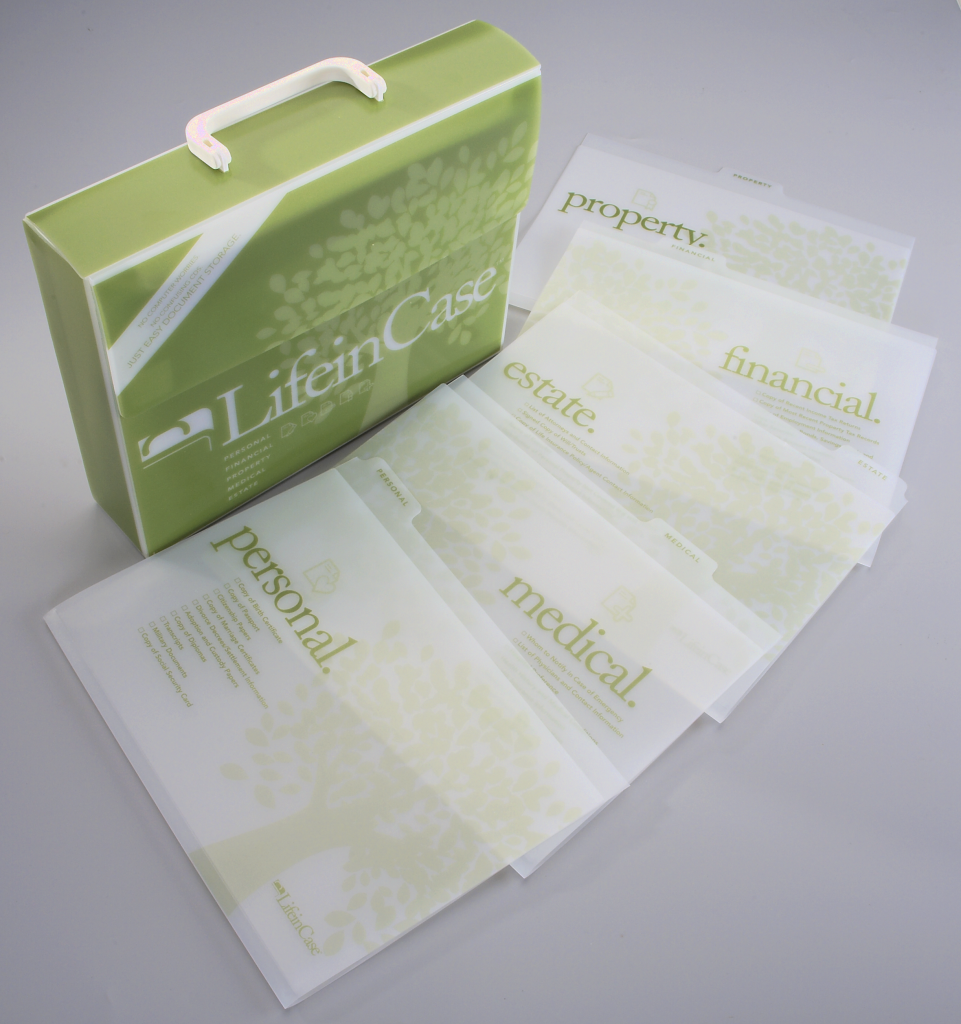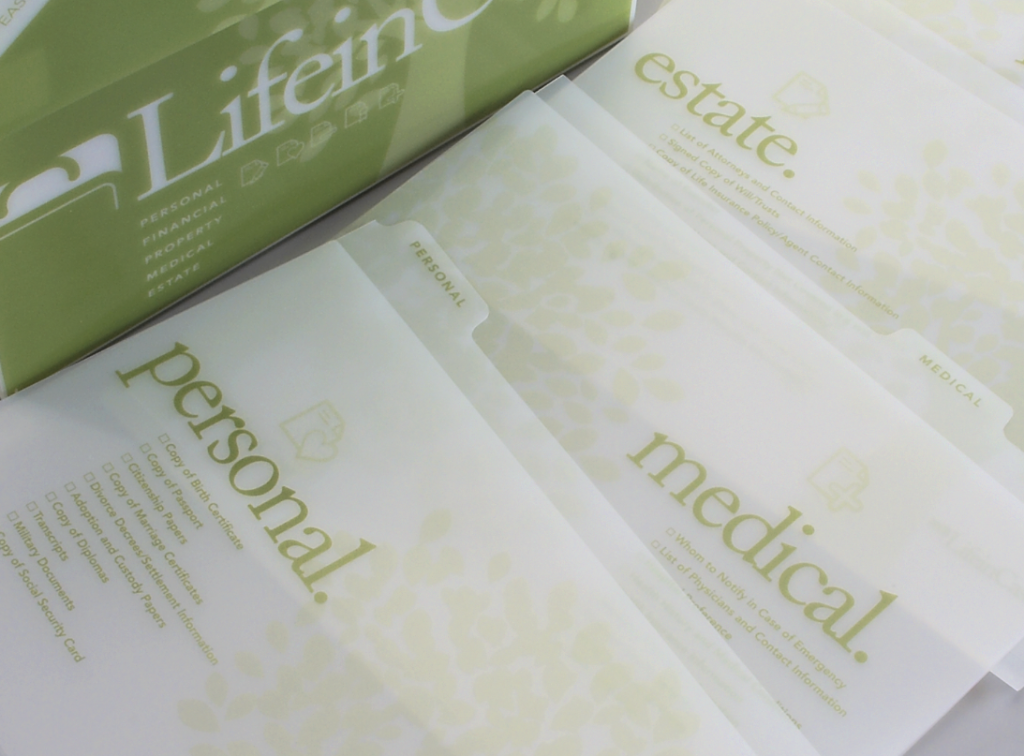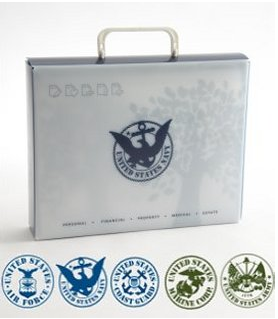NAPO2014: Just in Case? LifeinCase™
Chances are good that you’ve had reason to worry — at some point in your life — about evacuating your home or town in an emergency. Maybe it’s been a random conversation with your kindergartener about why you have fire drills at school but not at home, or you’ve read the federal government’s Ready.gov pages on emergency preparedness and wondered how you measure up. Or maybe you’ve had actual experience with floods or hurricanes, and don’t ever want to be caught unprepared for getting all your documents together.
Longtime readers know that Paper Doll advises having all of your VIPs (Very Important Papers) tucked safely away, as we’ve discussed in:
- Top 10 Vital Documents — Do You Know Where Your VIPs Are?
- More VIPs — Very Important Papers Beyond the Top 10
- Safeguard Your Very Important Papers: Safe Deposit Box Basics
- The Ultimate Treasure Map: Creating a Document Inventory
The truth is, whether you keep your most important documents in your safe deposit box, in a fire-proof safe, in your filing cabinet or even your deep freezer, you still need to deal with the following issues:
- Do you actually possess all of the documents you might need?
- Are all your documents accessible?
- Are they portable — and quickly — in case of emergency?
To ensure that you have all the documents you need, you can (and should) refer to posts and articles like those to which I’ve linked above. But knowing you ought to do something doesn’t always mean it gets accomplished.
With regard to accessibility, keeping documents (originals, or more likely certified copies) at home means that you don’t have to worry about the bridge between you and your bank’s safe deposit box being washed out when you need to show vital documents to your insurance agent. But even if your papers are at home, are they always protected (from theft and from the elements)? And what do you do when you travel, or especially if you travel frequently?
As much as I love clients being able to have a tidy VIP section in the legal area of their Family Files, in a dire emergency, you may not have the time or focus to search and find everything before you go. That’s why I was intrigued to see a new product at this year’s NAPO Expo that focuses, not just on another kind of filing system, but on easily maintaining and safekeeping vital documents.
LIFE IN CASE™ — THE BASICS
LifeinCase™ didn’t merely exhibit at the NAPO Expo. It won the prestigious 2014 NAPO Organizers’ Choice Award for Best Solution for Organizing Information at Home. Let’s see why.
Each LifeinCase™ features:
- A portable case: The poly, briefcase-style tote is lightweight but durable and water-resistant. It’s not going to act as a flotation device in case of a water landing, but it’s going to keep your documents relatively dry and safe if you’re escaping amid the harsher elements. The lid clasps shut with Velcro, so unlike three-ring binders which might fly open in brisk wind, documents are safe.
- A 5-folder system: LifeinCase™ has a poly folder for each of what the creators consider the five main categories of documents you’re likely to need in an emergency: Personal, Financial, Medical, Estate, and Property.
- Handy checklists: On the exterior of each folder, there’s a printed checklist of 10 essential documents to keep within that folder.
- 500 Sheet Capacity: The sturdy tote holds up to 500 pages, plus the folders. This is built to be a self-limiting system, so you keep storage to a minimum (of just the vital documents) and keep clutter at bay. This isn’t for all of your papers — just the papers you’d need in an emergency.
- Grab & Go: The LifeinCase™ tote can travel with you or be stored in a personal safe. Relocating? Let the movers take your locked filing cabinet, but keep your vital documents private and safely with you.
Also, for those who need or want to maintain access to certain cloud-based documents, LifeinCase™ has partnered with MobilLogic (about which, we’ve written previously), so individuals and companies can match up the paper files outlined in the LifeinCase™ checklists with personal or business systems, including electronic data.
THE FIVE CATEGORIES
For a little more detail on the categories and each folder’s checklists:
The personal category focuses on the essential VIPs specific to you, personally. These would be your birth certificate, copies of your passport and Social Security card, citizenship papers, military documents, etc.
The financial category limits itself to just the essentials you might need if you were displaced and needed to temporarily rebuild your world — such as after a community evacuation. These might include a copy of your most recent income tax return, a list of your credit cards (or, as Paper Doll recommends, a photocopy of the front and rear of all of the contents of your wallet), copies of stock and bond certificates (or at least their numbers and pertinent information), loan and credit contracts, etc.
The property category includes, as you might expect, property titles (for real estate, vehicles, boats, and whatever other real property you own), lists and details for any current mortgage, loan or lien documents, as well as a copy of tax assessment notices, purchase contracts, and records of capital improvements, in case they’re needed for insurance or tax purposes after structural damage.
The medical section would include contact information regarding whom to notify in case of emergency, health insurance information, a list of names and contact information for physicians and other healthcare providers, a documented history of medical conditions, and more.
Estate documents might include names and contact information for attorneys and estate executors, a signed copy of any wills or trusts, and copies of life insurance policies, including contact information for associated agents.
LIFEINCASE™ VERSIONS
In addition to the original LifeinCase™ green-on-frosty-white option, there are military-branded versions for members of U.S. Army, Navy, Air Force, Marines and Coast Guard.
THE STORY OF LIFEINCASE™
LifeinCase™ was developed by New Englanders Diane Hoyle-Moran and Mark Gibson. For more about the development of LifeinCase™, watch this recent interview with Diane on the Military Shopping Channel.
And below, a picture of Diane and her co-developer, Mark, clearly enjoying the NAPO Expo.
 FOR WHOM IS LIFEINCASE™ DESIGNED?
FOR WHOM IS LIFEINCASE™ DESIGNED?
LifeinCase™ probably isn’t for those of you who already have an intricate and organized document system set up, with myriad backups in place. But if you’re not sure what documents you have, or where you have them, or you (or someone you love) may not be the type to independently put these documents in order, LifeinCase™ gives you a swift kick in the rear for getting started and a little hand-holding to get you through to the end of the process. The checklists give the user the opportunity to say, “Hey, I don’t know where this document is — I’d better go look for it!” or, in the case of some document types (like estate paperwork), “Hey, I don’t even have this kind of document. I’d better make a call to set some important steps in motion!”
This would make a particularly great gift for new graduates, young(ish) newlyweds, members of the military, frequent travelers, and others who might not otherwise have the inspiration (or information) necessary to get started on organizing vital documents on their own.
LifeinCase™ is priced at $34.99 for the original and military versions, and is available at bulk discounts, so you’d save 15% off two cases, 23% off 3-8 cases, or 35% off nine or more cases.
However you organize your essential paperwork to make it accessible in case of emergency, the most important part is that you get started. Just in case.
BONUS UPDATE
LifeinCase™ has provided coupon codes for Paper Doll readers! When you order your LifeInCase™ systems, use the following codes:
BESTRESULTS for a 10% discount on the original green LifeinCase™ kits
BESTRESULTSUSA for a 15% discount on the Military Design LifeinCase™ kits








Follow Me